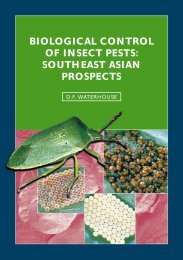Ploughman's Folly Ploughman's Folly - EcoPort
Ploughman's Folly Ploughman's Folly - EcoPort
Ploughman's Folly Ploughman's Folly - EcoPort
You also want an ePaper? Increase the reach of your titles
YUMPU automatically turns print PDFs into web optimized ePapers that Google loves.
een a matter for conjecture, though part of the explanation at least was advanced earlier in this chapter. A<br />
commonly held theory is that the organic matter hinders the progress of the water over the surface of the minerals<br />
in the soil, thus allowing more time for the minerals to soak it in. Doubtless there is some such effect. It may be<br />
more important than I think. It certainly is true that much of the water soaks directly into the leaves and other plant<br />
residues which are found on the ground. And we know that the entry of moisture into leaf tissue is much easier<br />
than into mineral soil.<br />
It may not be generally known that when water penetrates mineral masses it does so by finding its way between<br />
the particles. The tiny particles of clay, silt, or sand are almost completely exclusive. Water cannot enter them. It<br />
can only cling to their outer surfaces. This is extremely important information to keep in mind in a study of soils, for<br />
organic matter, by contrast, literally pulls liquids into itself. Volume for volume, then, organic matter can hold many<br />
times as much water as can any kind of soil mineral; for organic matter is chiefly open space internally, while<br />
minerals are dense, solid crystal; a fateful distinction where water relations are concerned.<br />
The idea is abroad that man is the lord of creation -- that he dominates the earth. In certain minor respects this<br />
may be true, but in the main it is the purest propaganda; as ineffectual, when we examine the facts, as whistling in<br />
the dark. Consider the single example of erosion. The alarm of thinking men today, when they consider the plight<br />
of coming generations starving on eroded soil, borders on panic. What would they think if there were immediate<br />
prospects of a renewal of the worldwide erosion which originally sculptured the present features of the earth's<br />
surface? That was erosion with a vengeance -- millions on millions of years of it. Mountains were buried in the sea<br />
by the tearing down of the original fire-formed stone of which they were composed, and the removal of the debris<br />
by the unhindered waters and winds which shuttled back and forth across such continents as then existed.<br />
Geologists still puzzle over the wreckage, trying to piece out the story.<br />
That original large-scale erosion was finally curbed. But it was not done by that self-advertising animal called man.<br />
It was done by vegetation -- plants. Plants, the conquerors, had to start from nothing but powdered rock. Some<br />
structural materials they extracted from the minerals themselves, some from the air and the rays of the sun, and<br />
the rest from water. The porous architecture they were able to create from these materials is still the wonder of<br />
existence, though so commonplace as not often to be even an object of curiosity. A casual glance at a bit of onion<br />
skin, or a few strands of algae, under a microscope is a revelation to the uninitiated, even though no further<br />
thought is given to it. If it is considered that this delicate, lacy network of cells could not be possible except for the<br />
presence in infinitesimal amounts of such chemicals as phosphorus, iron, sulphur, calcium, potassium, and<br />
magnesium, the miracle of life becomes apparent. To know, then, that world-wide erosion was curbed in the<br />
beginning by stuff similar to that on the microscope slide should give us a healthy respect for all plants and for their<br />
disintegrating remains; for, down to the last black colloidal remnant of the dead plant or animal tissue, organic<br />
nature continues to fight erosion by the trick of absorption. By eternally coaxing water to enter, organic tissues<br />
keep it under control. Hence the importance of having the organic tissues where the water can reach them the<br />
instant it hits the earth as rain.<br />
Plants are the real masters of the earth. Independent of human management, since they antedated the race,<br />
plants came spontaneously from the sea and threw a restraining influence over the unstable surface of the land,<br />
quieting its restlessness. Botanists explain the process in detail and with plausible reasoning, allowing eons for the<br />
lapse of time from the first single cells to the giant sequoias, and other eons for suitably equipped plants to<br />
complete the vegetative mantle over the earth. Moses offers a different story, of course, but be that as it may, we<br />
can be sure that man will master the rest of creation only as he comes to terms with plants, the real masters. They<br />
hold the key to his food supply.<br />
Admittedly, we have serious erosion to contend with now. Much of our land is again in almost precisely the<br />
condition all land was in before plants arrived. It is bare, and it is in movement. Yet the present situation is<br />
immeasurably more favourable than the earlier one. The same destructive forces of wind and water are at work<br />
now as then, but the forces of plant opposition are now fully organized and mobilized. Alone, unless interfered with<br />
by man, plants can reclaim wayward land in an infinitesimal fraction of the time that was required eons ago, before<br />
they had adapted themselves to such work. Even so, such a reclamation period, when measured in terms of<br />
human lifetimes, may be excessively long. We are likely to get hungry waiting for natural forces alone to stop<br />
erosion and restore soil to the eroding mineral surface. Men must lend a helping hand.<br />
The processes by which vegetation accomplishes a new cover where the previous cover has been destroyed are<br />
neither secret nor mysterious. All botany texts and a variety of other scientific treatises discuss the influences that<br />
determine the development of plant communities. These factors have been so ably discussed elsewhere that there<br />
is no necessity for my doing so here. It may be pertinent, however, to introduce some of the underlying principles<br />
which determine the nature of plant successions as they occur.<br />
Important among the life factors that occasion the growth of one plant as against another in a given location are<br />
the requirements of the species for water and for heat. Although the temperature of the air is influenced to a certain<br />
extent by the soil, we may pass it over, because it is not of major concern. Water, being literally managed by the






